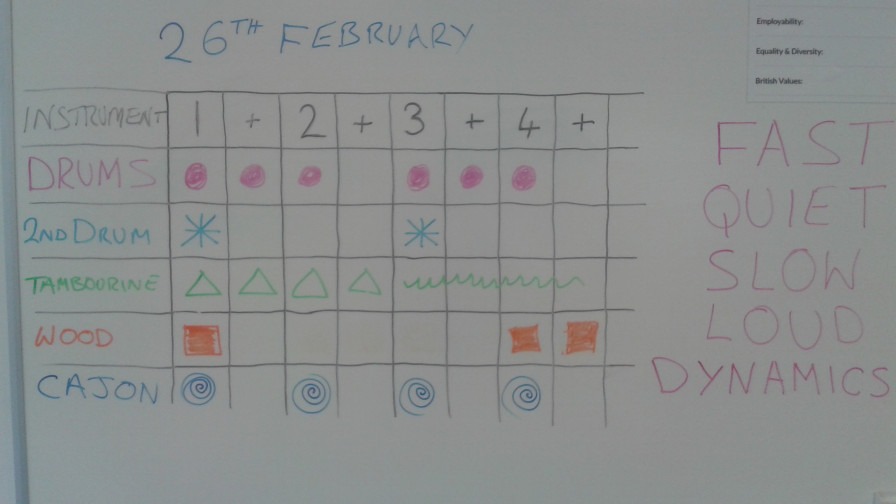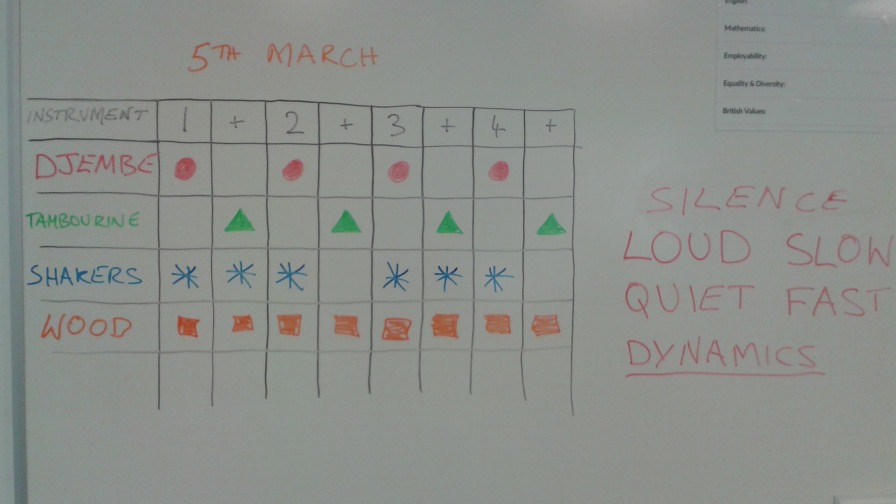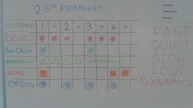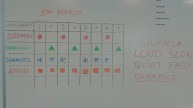Stretching and challenging our percussionists

We do many exciting things in our project with our inspiring musicians and I am always looking to push them that little bit further. In our percussion groups we have used words and props to signify beats for quite a while and these have become part of our musicians’ creative repertoire. They have developed their own rhythms using the words “tea”, “coffee”, “lemonade”, “pepsi-cola” and the visual props of tea bags, coffee cups and drinks cans. They respond well to both of these and enjoy building complex sequences and detailed rhythms.
Always looking to push our guys, I was searching for ways to develop their rhythmic skills and musical understanding. I thought I might introduce the rhythm grid to our two percussion groups so I discussed this with staff from the college in which we deliver some of our project. They encouraged me to give it a try so I did. The results were amazing!
We are now using terms such as “count 1 and 2 and 3 and 4 and”, using words such as “bars”, “repeats” and so embedding counting and wider vocabulary within the music making. Our young musicians have really taken to this and are able to remember from week to week these musical concepts and they love building up their complex rhythm pieces. Add to this “fast”, “slow”, “quiet”, “loud” and they are now dealing with “dynamics”, a new word they are able to embrace and explain. This has been wonderful to see for young people with a variety of cognitive, physical and behavioural challenges. This is quite advanced stuff and they have really pushed themselves to focus and progress.
As you can see from the attached picture of one of our grids, each instrument has a row and each beat of a bar has a column. Participants can plot the beats of their instruments across the bar which is immediately visible to them. This allows the group to build up a complex, layered piece and to own the individual parts which they have created as well as the whole which has arisen from collaboration with the group. We use colour coding for the instruments and the symbols we use on the grid and this provides visual clarity and continuity. I am aware that many people use these grids in many settings and I can see why. They can be as simple as needed in the beginning and easily developed for achievement and differentiation.
As I said, the results have been absolutely amazing. It is always good to stretch and challenge young musicians but sometimes we may be a little anxious about doing so. This is especially the case in an SEN setting and it is important to cater for all abilities and personalities. Our use of the rhythm grid has proven to be a real success in many ways and I would encourage any percussion workshop leaders to consider using it with their musicians.
You can see the wonderful results of some of our grid-based work on our FaceBook page:
https://www.facebook.com/VAEFMusic/




